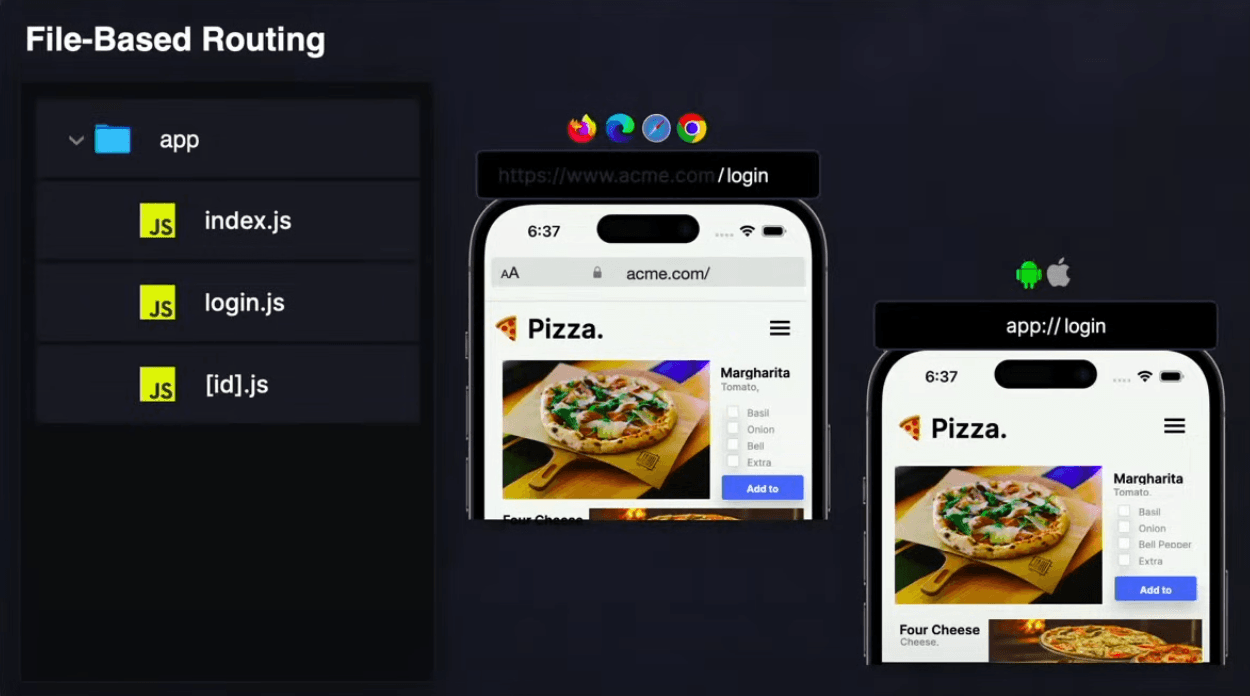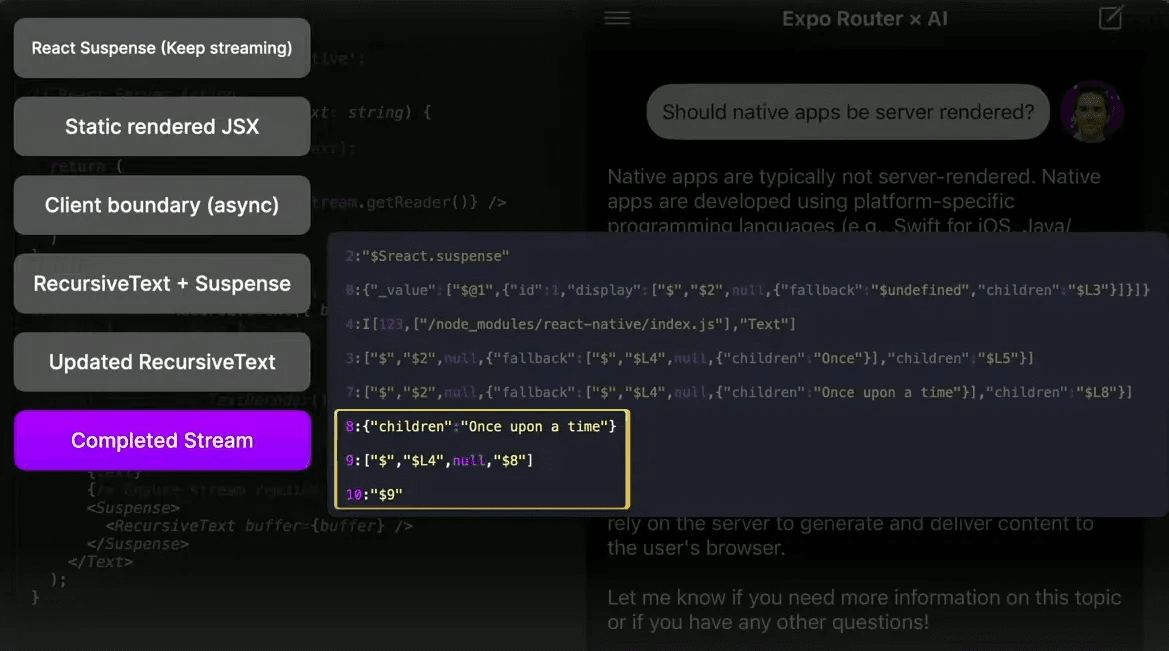Introduction
The biggest React Conference, organized by Meta and Callstack, wrapped up recently. It was a two-day event that started on May 15th, filled with exciting announcements.
The most exciting announcements, that we will dive into today, were:
- React 19 RC (Release Candidate)
- React Server Components in Expo Router 🔥
- React Compiler 🚀
Let’s dive in 🚀
React 19 RC
React team announced React 19 as RC (Release Candidate) which means React 19 will be stable in the next few weeks. Also, react 19 RC is now available on npm as V18.3. One of the most exciting parts of React 19 is that RSC (React Server Component) is now stable and will not break between major versions. Let’s explore RSC in-depth. 🚀
What is RSC?
RSC (React Server Component) is a rendering technique where the Server can send fully interactive, dynamic UI components (Ex: custom sliders) to the client (web, desktop, or Mobile device).
RSC allows developers to write components that render on both the server and the client. It also allows for selective rendering of components on the server, which means only the necessary components are rendered, reducing the server’s computational load. In RSC, initial rendering happens on the server, improving performance and reducing user wait time.
In the next section, we will learn more details about how RSC works from Evan Bacon's talk.
NOTE: 2 more rendering techniques in React World came before the birth of RSC.
- Client Side Rendering (CSR)
- Server Side Rendering (SSR)
Client Side Rendering (CSR)
In this rendering technique, the final HTML content and user interface (UI) components are generated on the client's browser or Mobile app using JavaScript.
Client-side rendering can cause slow performance and SEO issues, so SSR (Server Side Rendering) came to improve loading times and page visibility for search engines.
Server Side Rendering (SSR)
This rendering technique is used in web development where the web page's content is rendered on the server instead of the client's browser & then sent to the device as JSON (a static UI representation) which makes the UX (user experience) faster page transitions & better SEO.
Pretty cool SSR, right? But wait, did you notice that in the line above, we mentioned SSR uses JSON (basically HTML)? Yes, that JSON is not interactive. So, to create a dynamic and interactive UI, RSC came into the spotlight 💯.
React Server Components in Expo Router
So, the most exciting news from React Conf 2024 is that Evan Bacon from the Expo team has introduced React Server Components across all platforms (web, desktop, mobile) via the Expo Router.
To learn more about this talk, let’s first understand what the Expo Router is.
The Expo Router
Expo Router is the first file-based routing system to build react apps that run on both web & native platforms.

With the help of Expo Router, the RSC server can handle multi-platform requests. When a request is made from an iOS or Android device, or even from a web browser, the server recognizes the platform and renders the appropriate version of the server components.
Server-driven UI: RSC
There are some mobile apps (e.g., Lyft, Netflix, Reddit) that implement a server-driven UI in their native applications, which can be quite complex to configure. They are using some common architecture such as JSON (a static UI representation by HTML for a custom native application). However, this JSON does not facilitate user interaction with the UI.
Here, RSC (React Server Components) has advanced this concept by directly sending JSX components from the server to the client (web, desktop, or mobile device) to handle user interactions.
RSC with Expo Router
The main goal of Expo Router is to make this server-driven UI interactive for developers. Below, we see three mobile applications that were showcased at the conference.
- ChatGPT 4 App: It utilizes a server-driven UI with JSON. Since JSON is a static UI representation, it does not allow users to interact with the UI (e.g., clicking a button to reveal more data about an image).
- Gemini AI App: It is the same as the ChatGPT 4 application.
- Expo Router AI App: It also uses Server-driven UI but with an RSC data pattern (where server sends directly JSX code to the client device). This enables users to interact with the UI seamlessly. For instance, Evan Bacon demonstrated this by performing a long press on an image, which then opened a menu. Moreover, the RSC data pattern allows for the integration of native access, such as scheduling a date in the calendar, with the rendered JSX component.

In the Expo Router AI app, we observed Evan Bacon demonstrating a Map view (below). This Map view is a client component because it relies on the Native API. However, all the data for this Map was fetched on the server, and the carousel at the bottom, which we also received, was rendered using a React Server Component.

NOTE: The RSC server sends only JavaScript code to the client. It does not transmit any native bindings or native code (for example, Calendar API, Map API, etc.) to the client’s device.
Now, let’s learn a bit about the data pattern that RSC uses.
RSC data pattern
When a client (web or mobile device) requests the Server then an RSC payload (static representation of the JSX code) is sent back with suspense (loading components) to keep the stream open.

These are the key points that an RSC payload carries and executes during the stream’s progress:
- It carries the root JSX code in a static representation (JSON) format.
- It then carries a URL that contains only the client code (Client JS bundle), which is necessary for RSC to load (hydrate) to be interactive for handling user actions.
- Subsequently, it carries the currently rendered UI element (Ex: Text element). React’s Suspense feature is used here to ensure that the server can keep sending updates to the client (Ex: At first server sent "Once" and then sent "Once upon a time"). As more data is sent from the server to the client, the page or screen can keep updating with new content by updating the react tree. This continuous update process enables the client application to respond instantly to user interactions, resulting in a seamless experience.
- Finally, once the stream is complete, React will terminate the connection.
Below is the final data pattern illustrating how the RSC server transmits data to the client (web, desktop, or mobile), as presented by Evan Bacon on stage.

React Compiler
Finally, the React team has announced an experimental release of the React compiler 🚀. The community has made huge comments on this. Let’s explore it more here.
It is a build-time-only tool that automatically optimizes your React application. It works with plain JavaScript and understands the Rules of React (which we will discuss later), so there’s no need to rewrite any code to use it. If it detects violations of the rules, it will automatically skip those specific components or hooks and continue to compile the rest of the code safely.
How does React Compiler work?
To optimize applications, the React Compiler automatically memoizes your code. You may already be familiar with memoization through APIs such as useMemo, useCallback, and React.memo. With these APIs, you can inform React that certain parts of your application don’t need to recompute if their inputs remain unchanged, thereby reducing the workload during updates. If your codebase is already well-memoized, you might not see significant performance improvements with the compiler.
What React Compiler memoize?
The initial release of the React Compiler is primarily focused on these two areas to improve app performance by memoization.
- Skipping all <Child/> components from re-rendering when <Parent/> component state got updated.
- Memoizing all expensive calculations.
Points to remember
Let’s see the below code snippet:
// **Not** memoized by React Compiler, since this is not a component or hookfunction expensivelyProcessAReallyLargeArrayOfObjects() { /* ... */ }// Memoized by React Compiler since this is a componentfunction TableContainer({ items }) {// This function call would be memoized:const data = expensivelyProcessAReallyLargeArrayOfObjects(items);// ...}
- React Compiler only memoizes React components and hooks, not every function: In this above code, we see that function expensivelyProcessAReallyLargeArrayOfObjects() will not be memoized by React Compiler as it is not a component (react component returns a React element) nor a hook (hook manage states). The function in this case is just processing an array of objects.
- The React Compiler’s memoization works separately for each component or hook: If you have a function like expensivelyProcessAReallyLargeArrayOfObjects() that’s used in several places, it will do the same heavy calculation each time, even if you’re passing the same data.
Rules of React
Let’s easily understand which React rules should be followed to fully achieve the power of the React Compiler.
- Components and Hooks must be pure: Below are the conditions to be pure.
- Always produce the same output given the same inputs.
- No side effects (Ex: API calls, setTimeout, setInterval, etc) during the rendering phase.
- Component Props and states can’t be mutated (changed) directly.
- Return values and arguments to Hooks are immutable (read-only).
- Don’t mutate (change) values after they’ve been used in JSX.
- React calls Components and Hooks
- Don’t call components like regular functions (Ex: Don’t call by Component(). Instead, call it by <Component/>).
- Hooks should only be called inside of components.
- Rules of Hooks
- Only call Hooks at the top level of the component
- Don’t call Hooks from regular JavaScript functions.
That’s it 🙌
React Conf 2024’s key announcements included the open-sourcing of the React Compiler, the release candidate for React 19, React Server Components (RSC) in Expo Router, and React Router v7, among other updates.
Did you learn something new today?
If you found this post valuable, share it with one friend or coworker that can benefit from it as well. That would be much appreciated 🙏
The post was written by Anis and edited by Vadim Savin.



